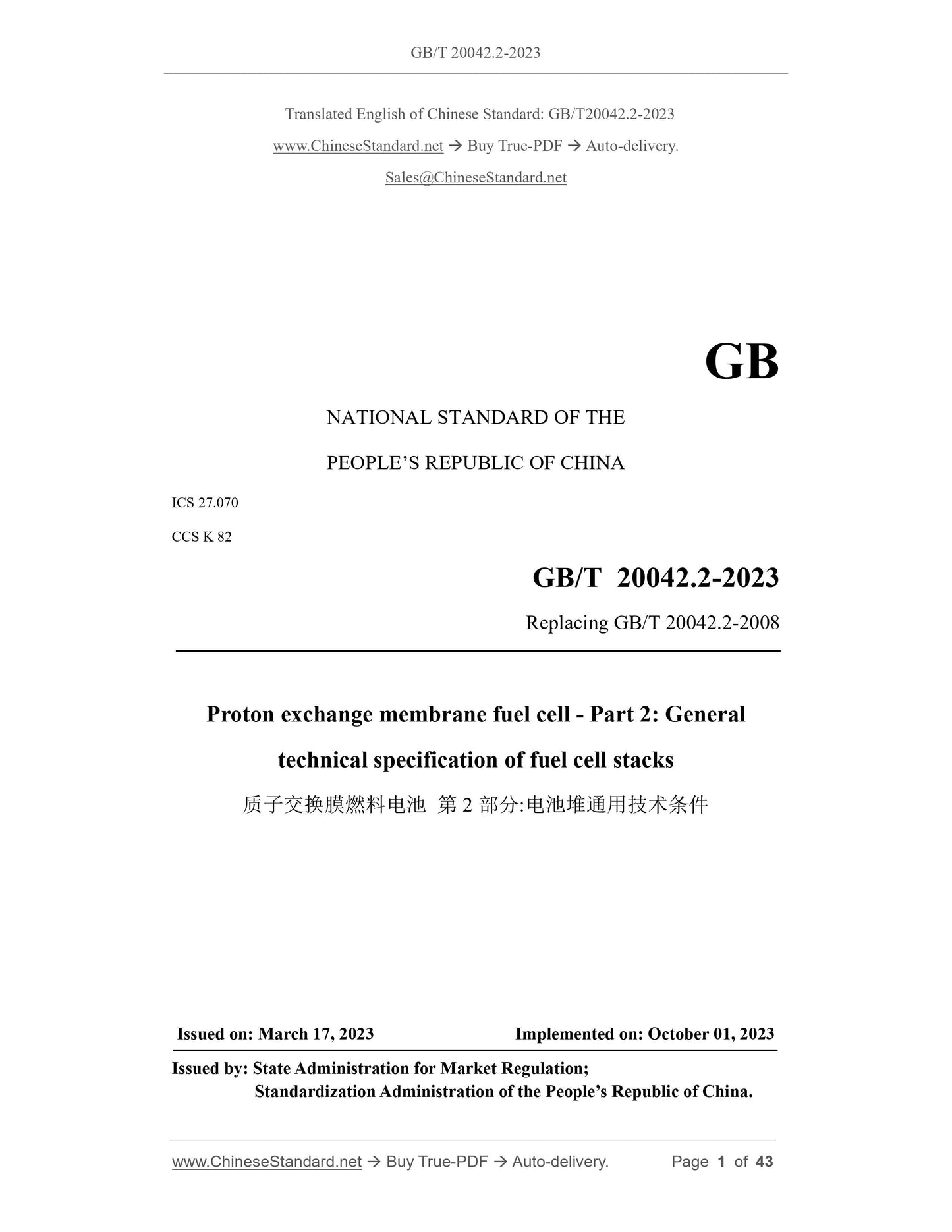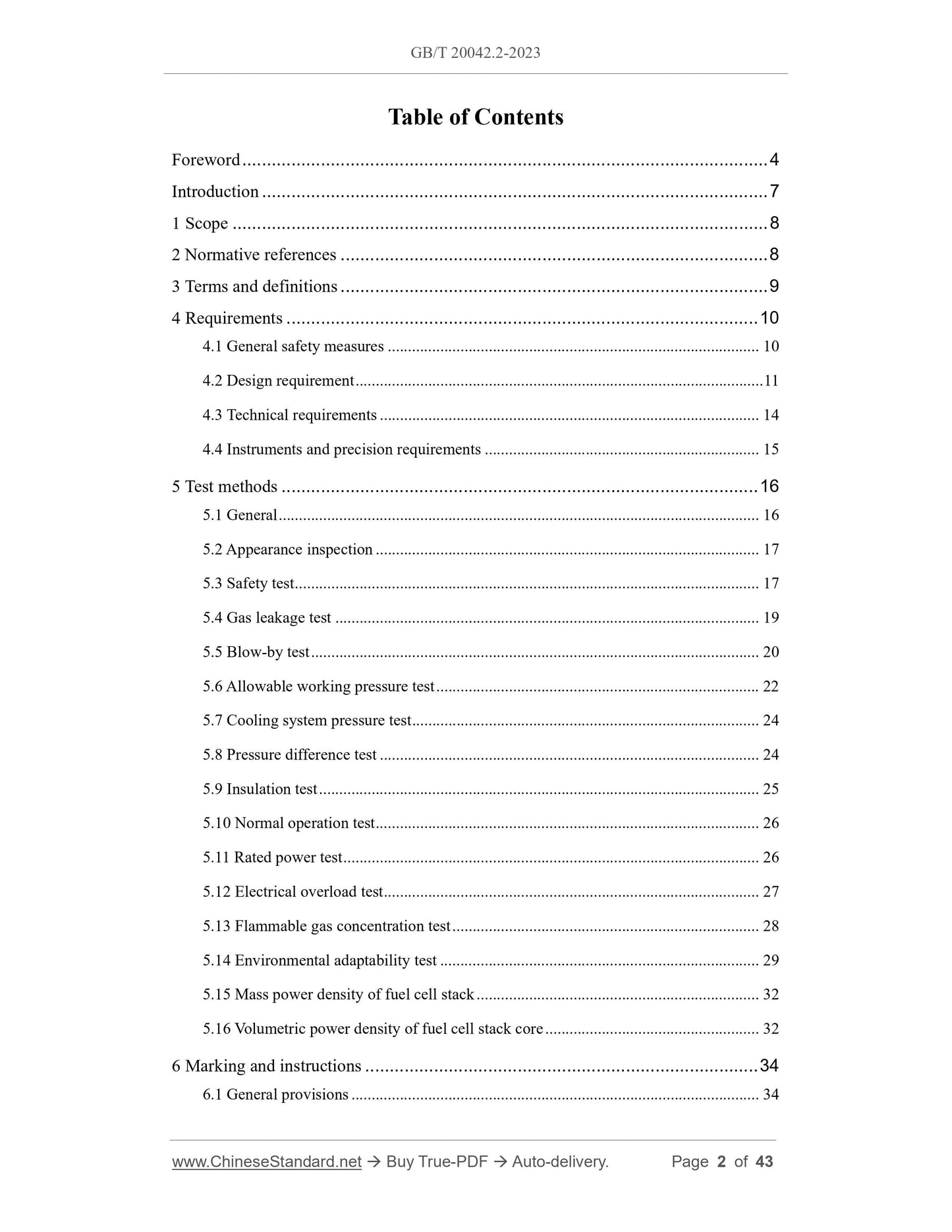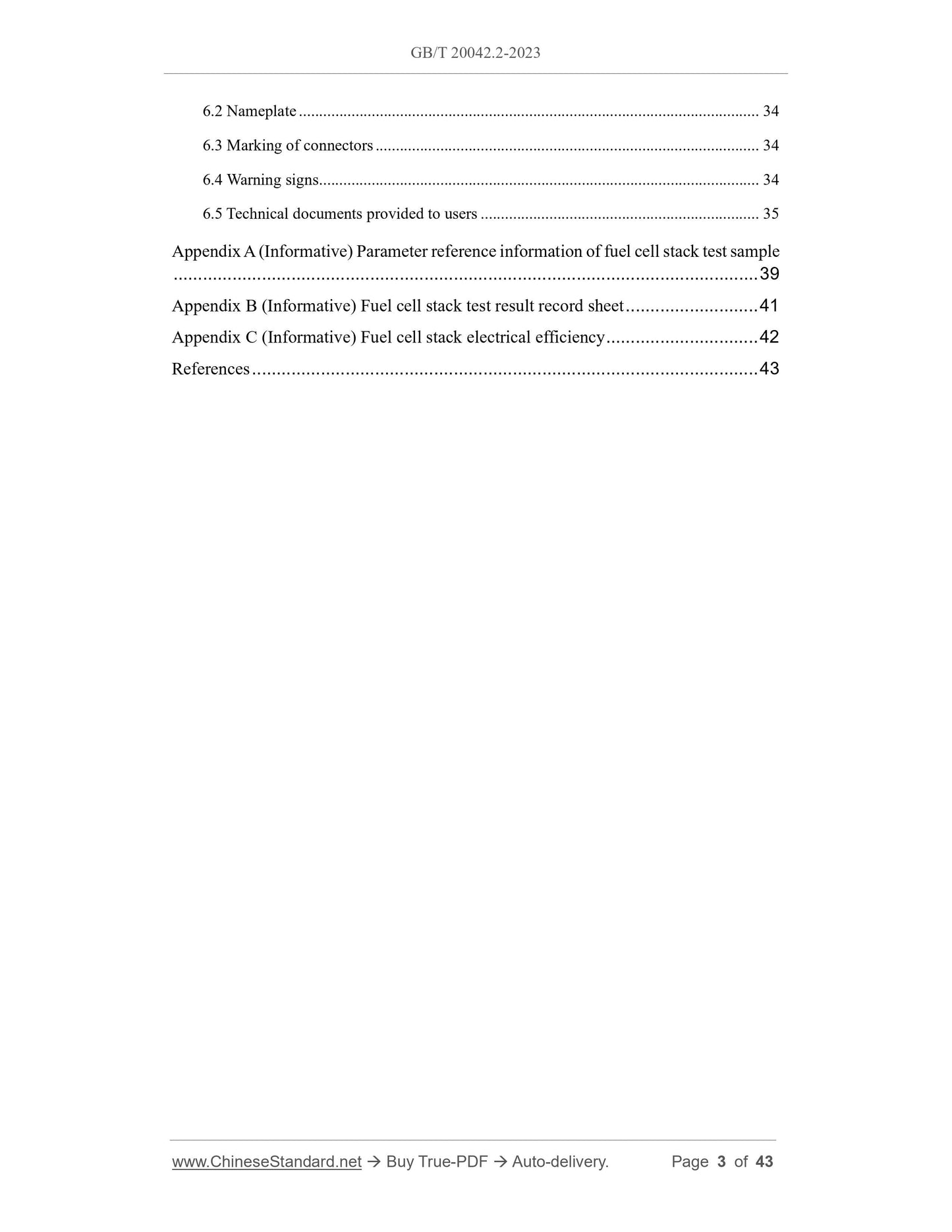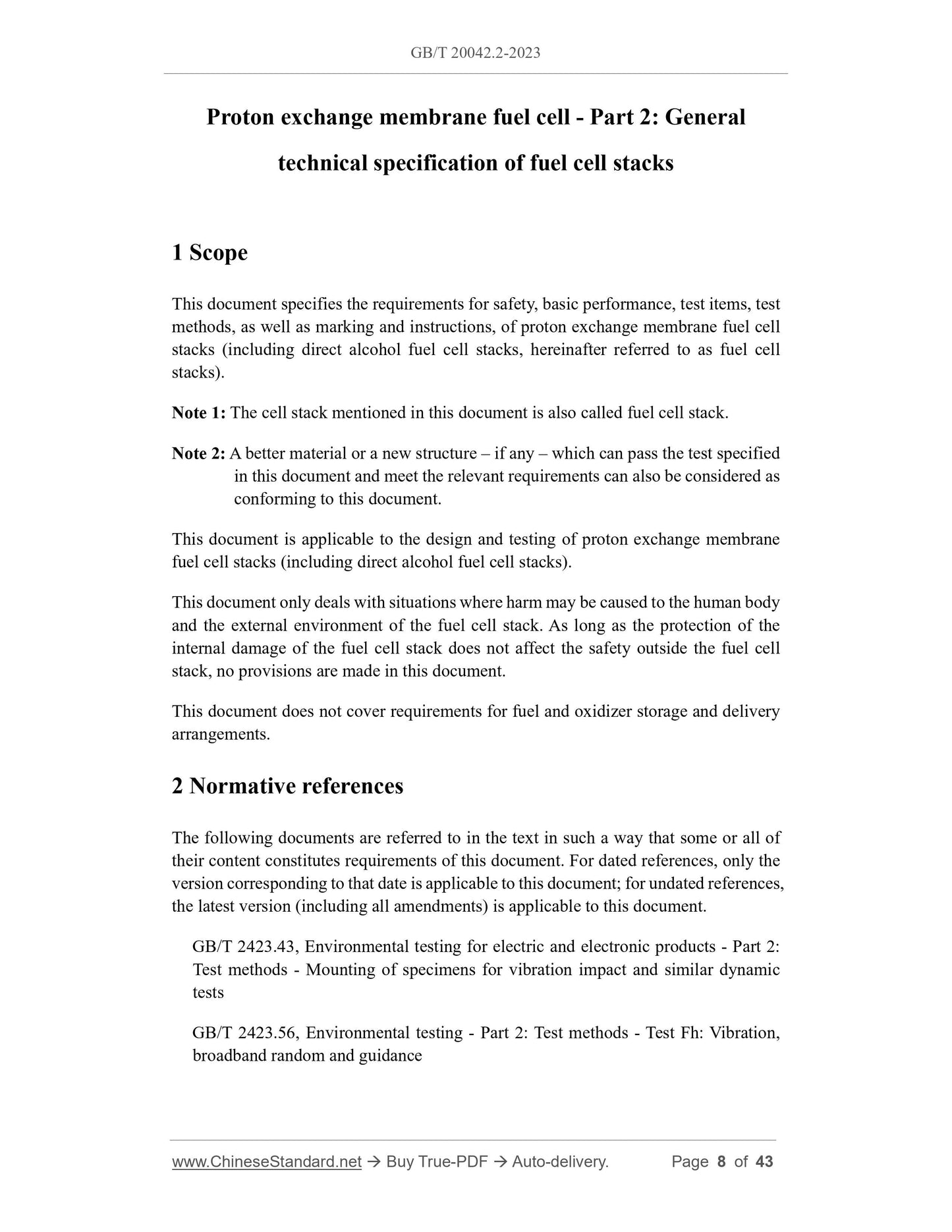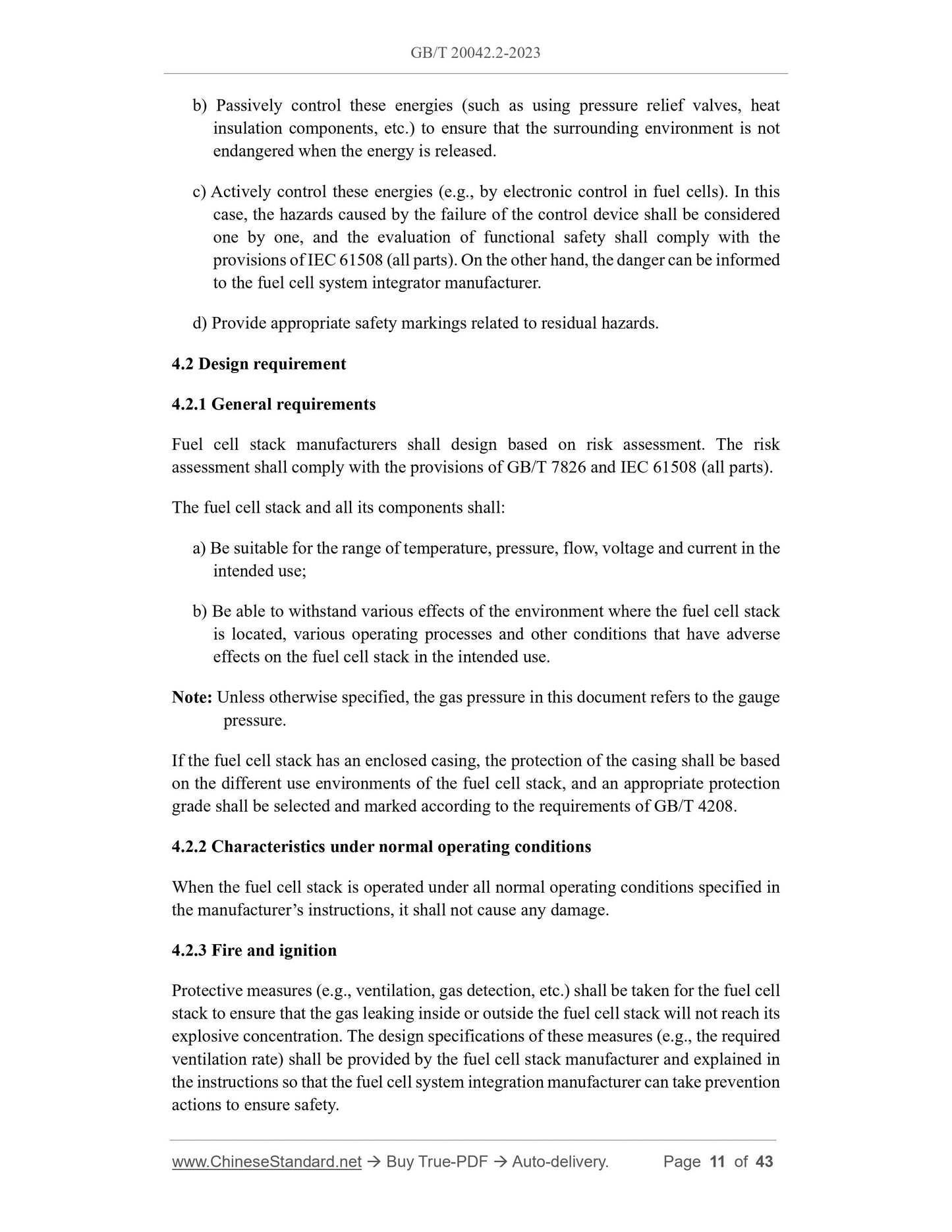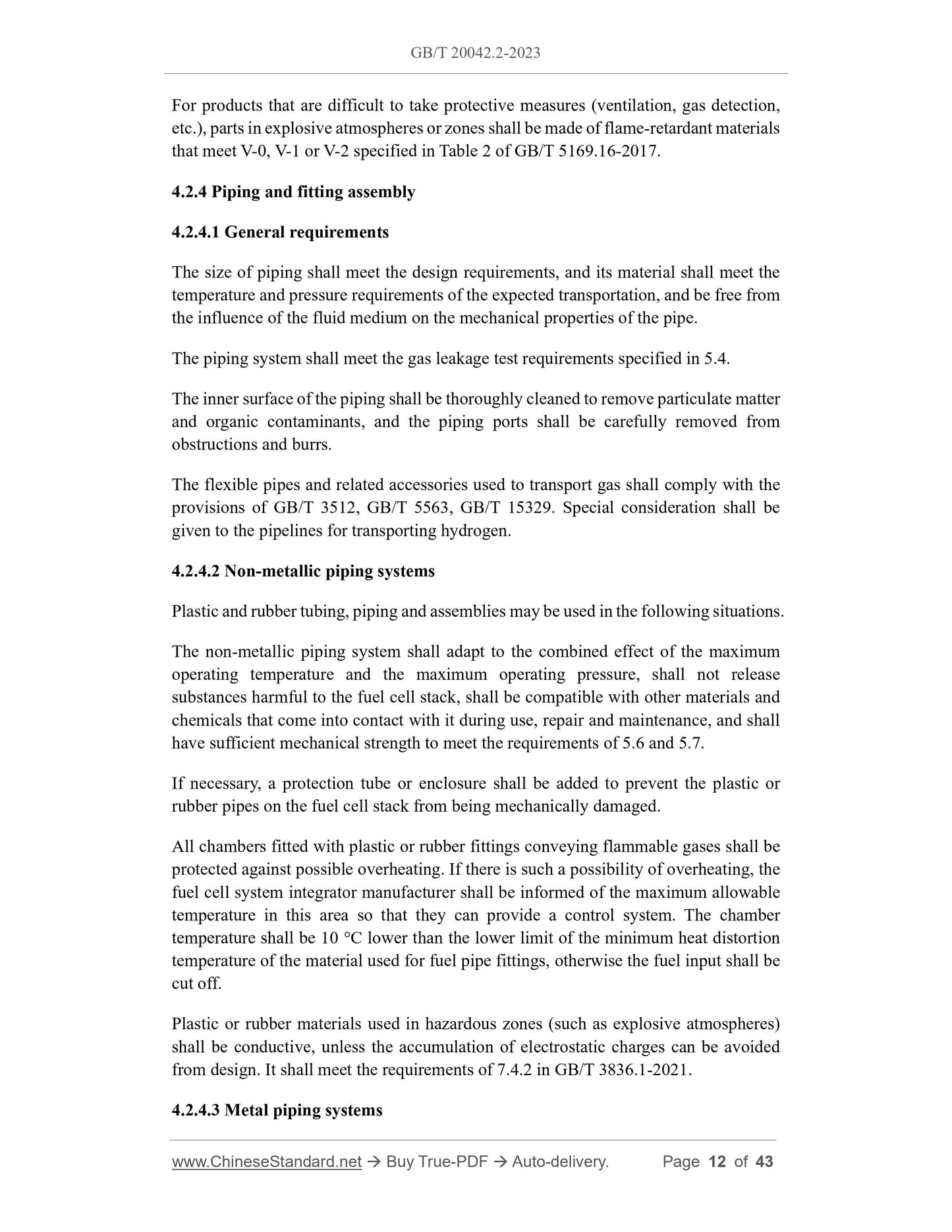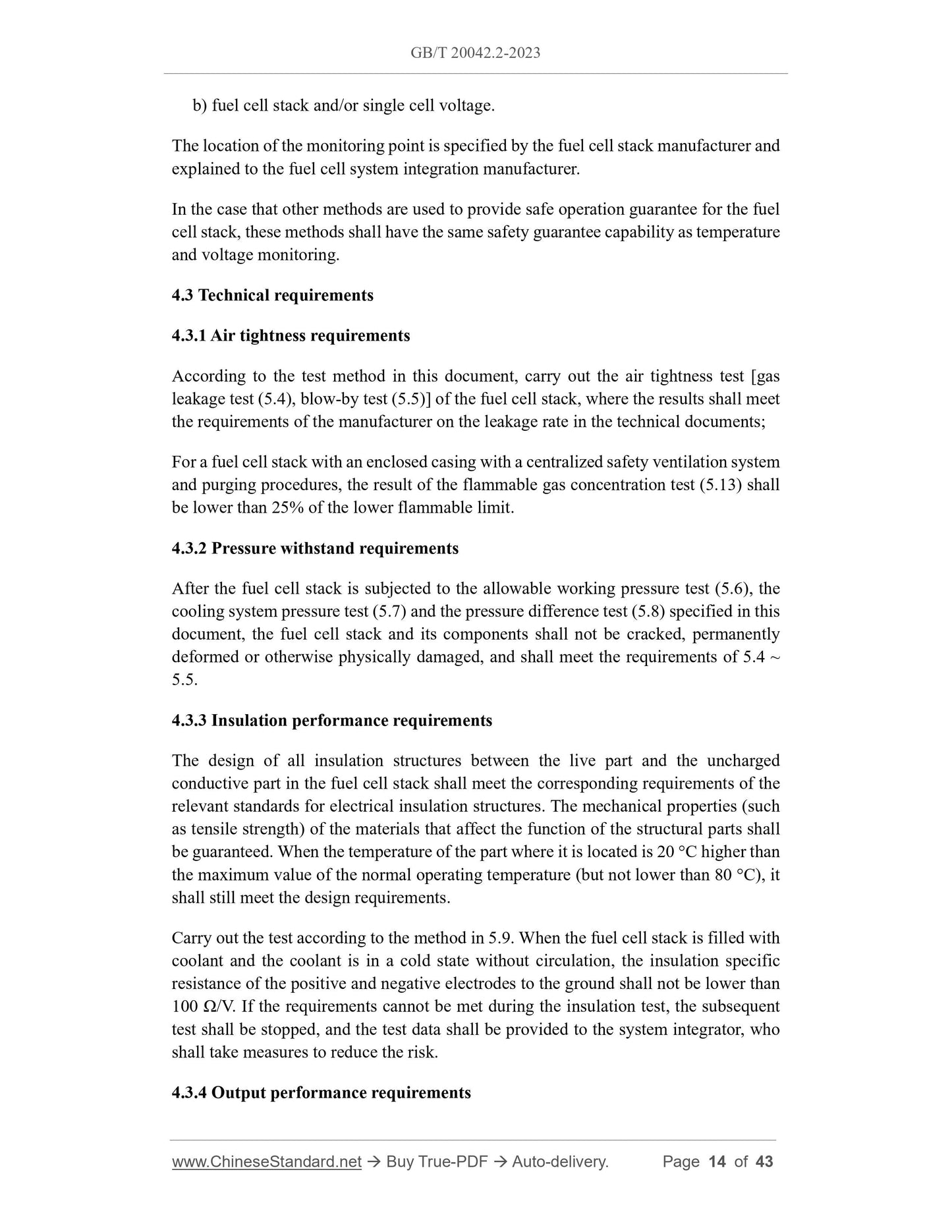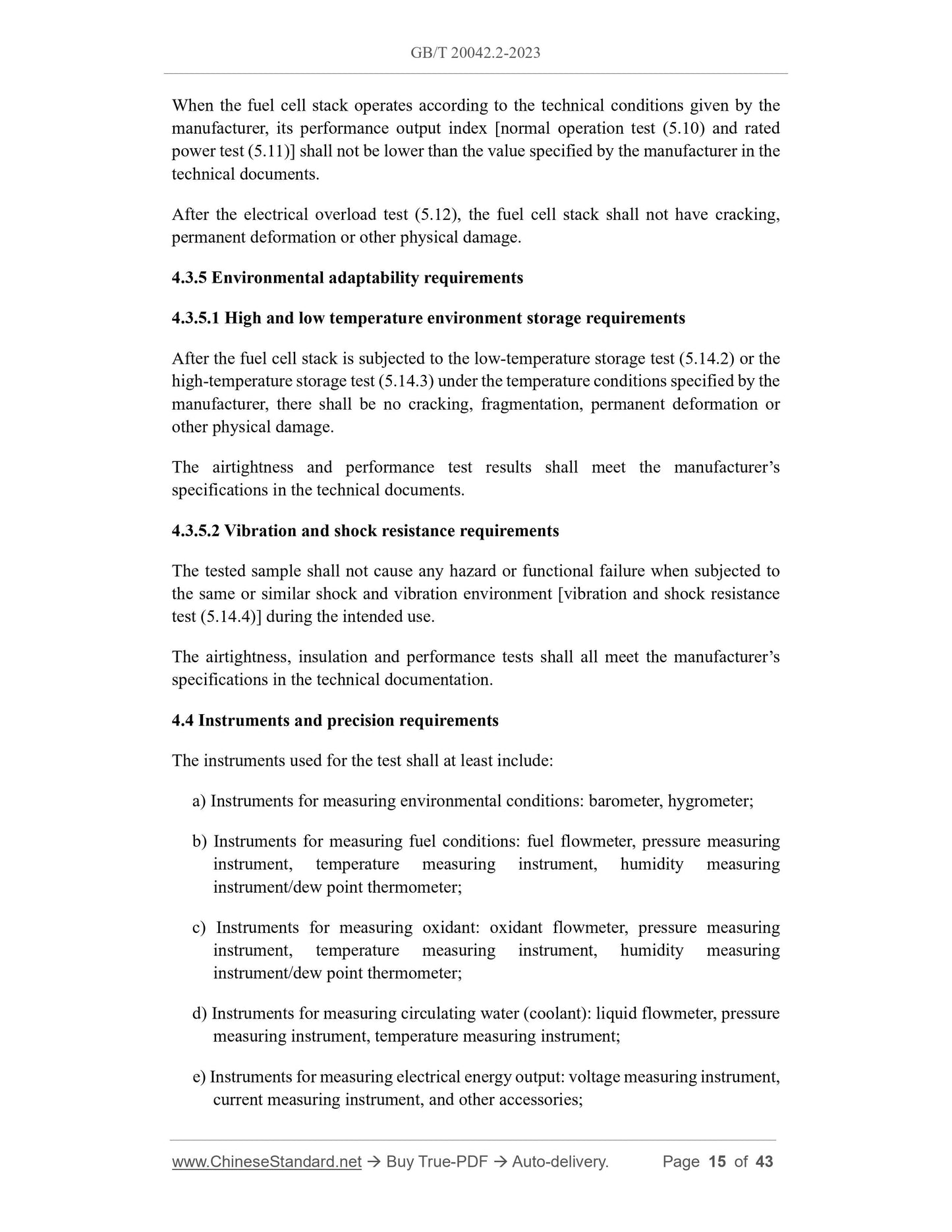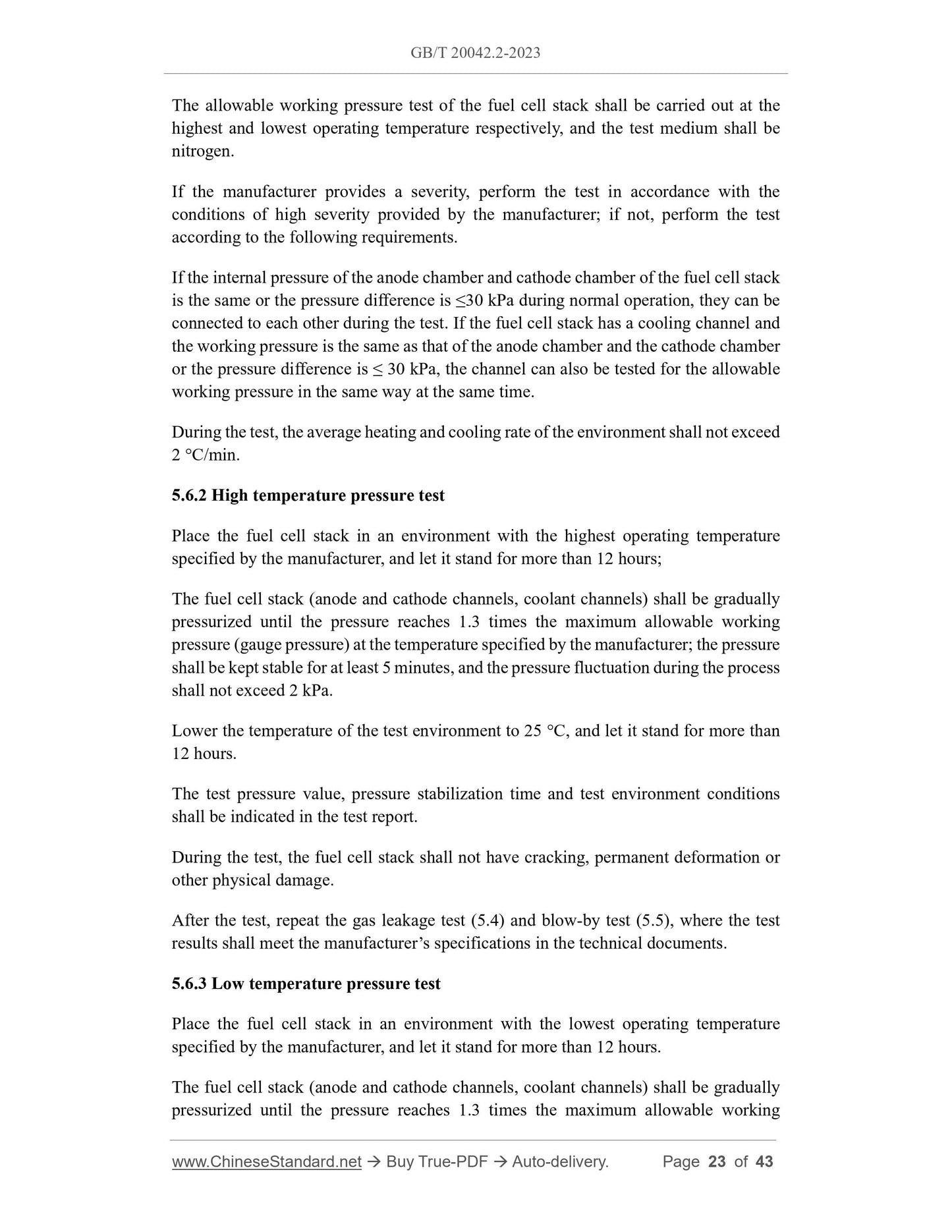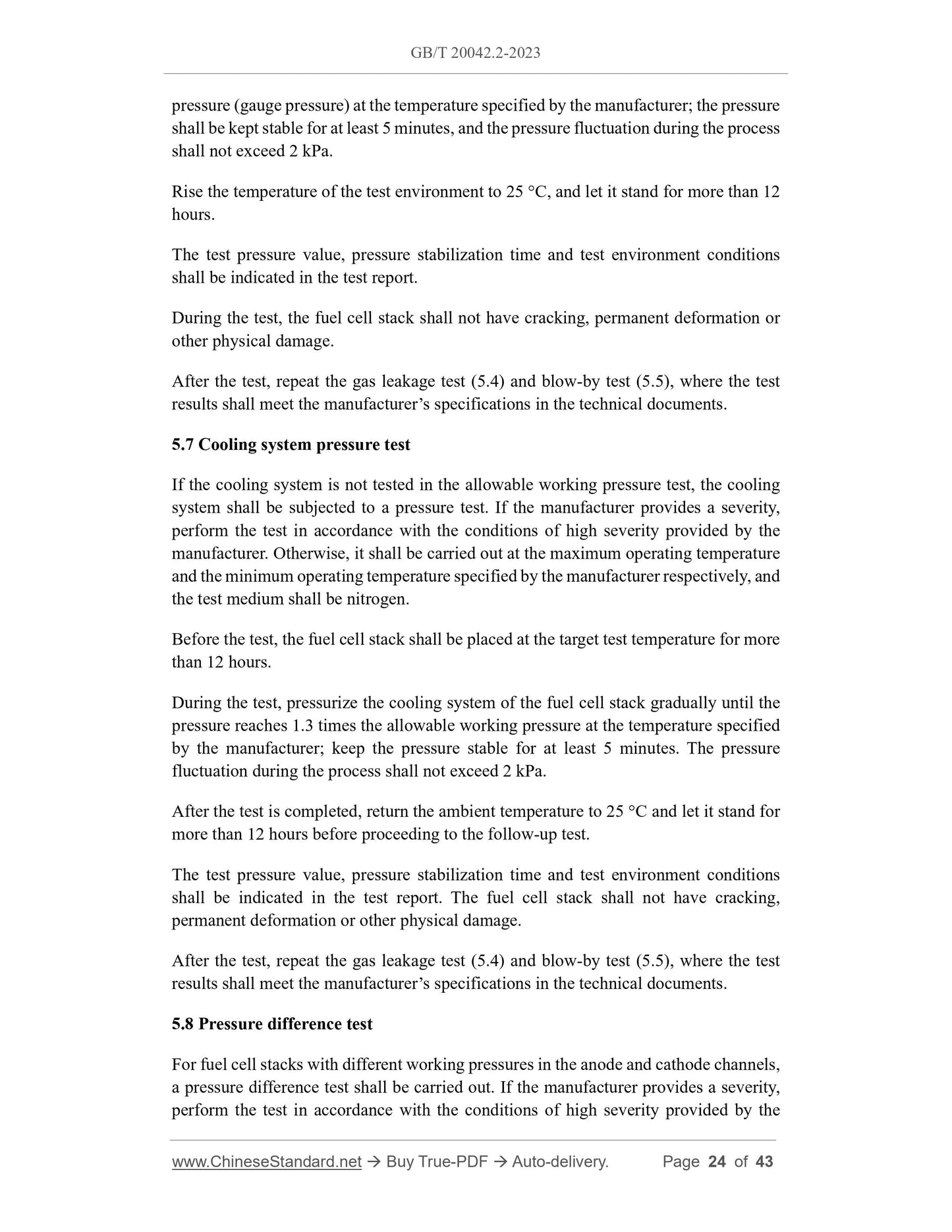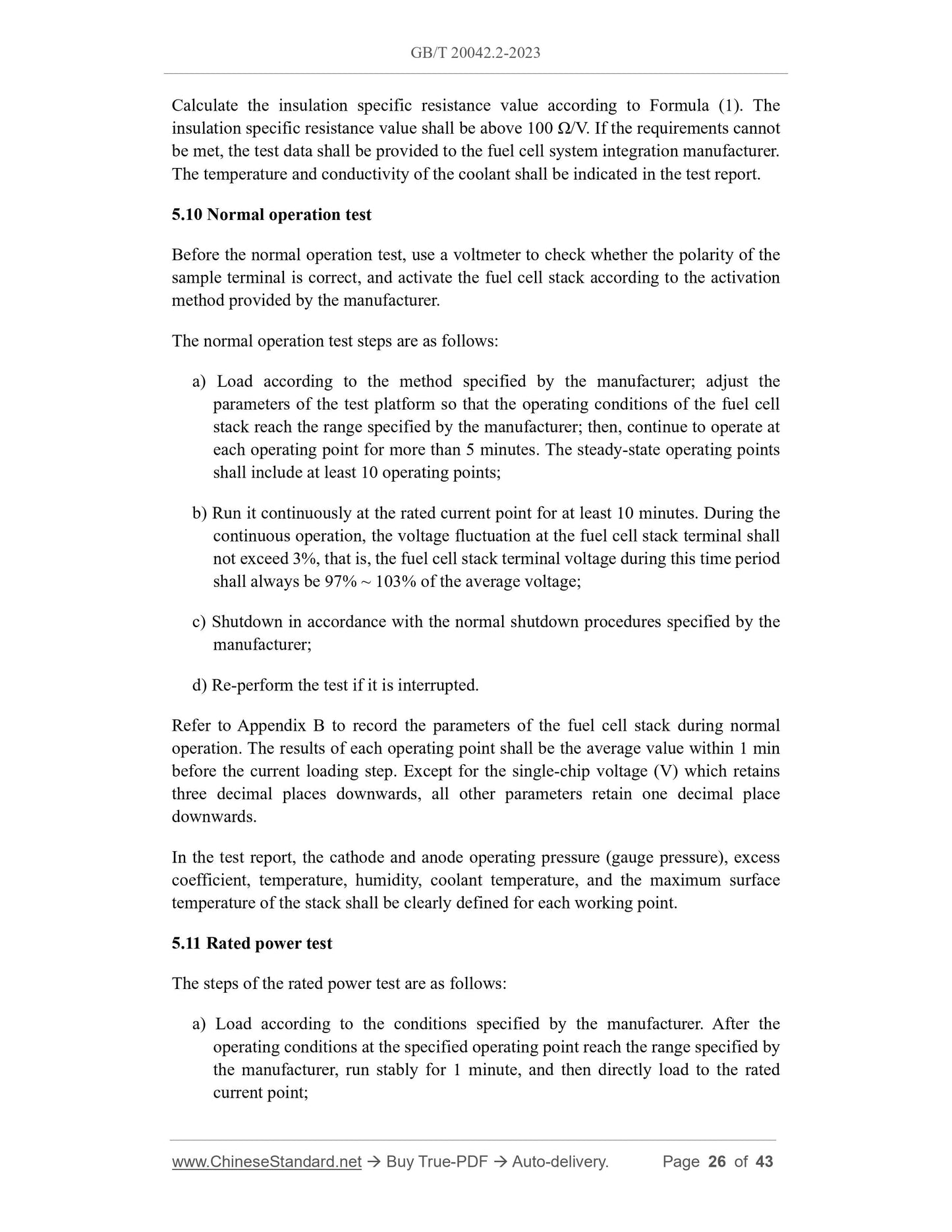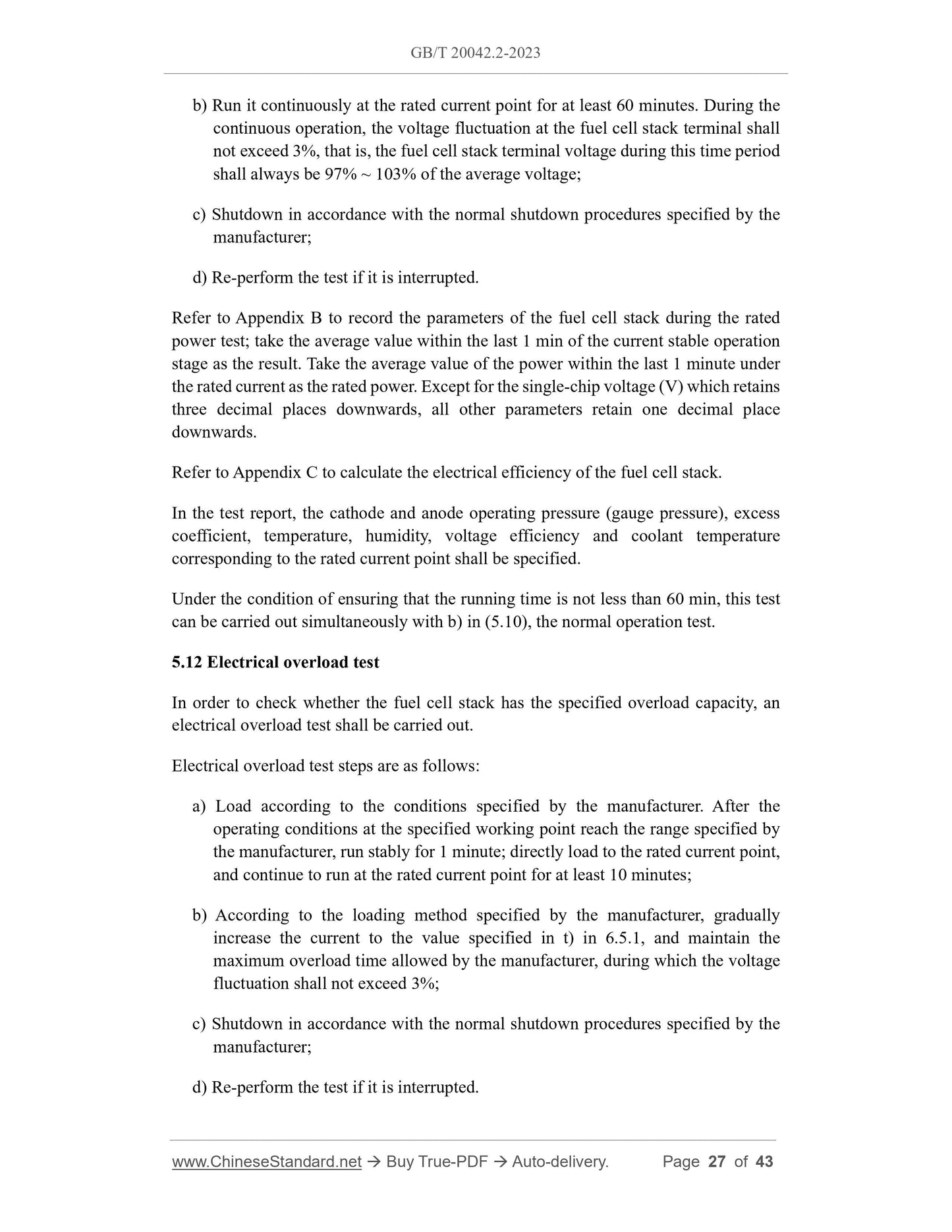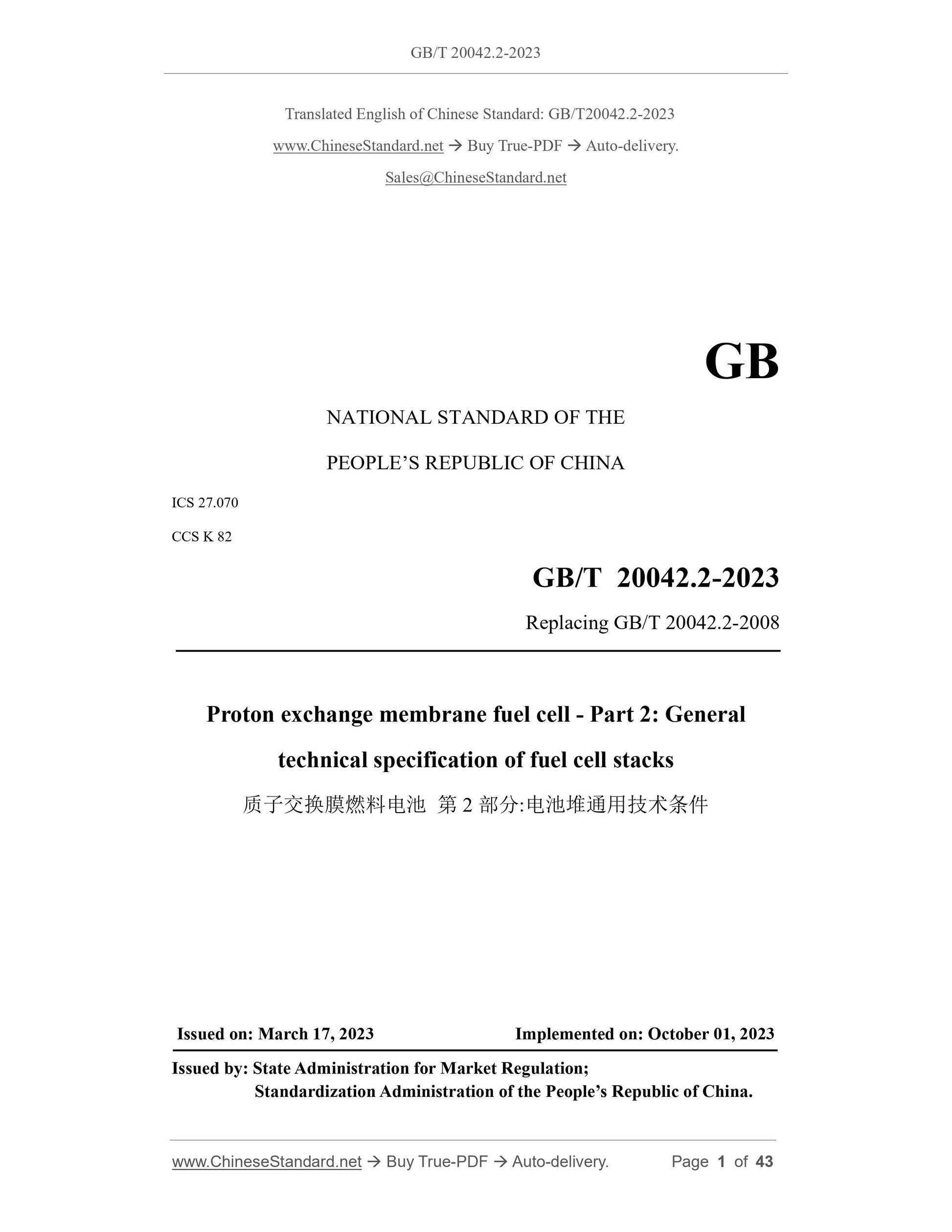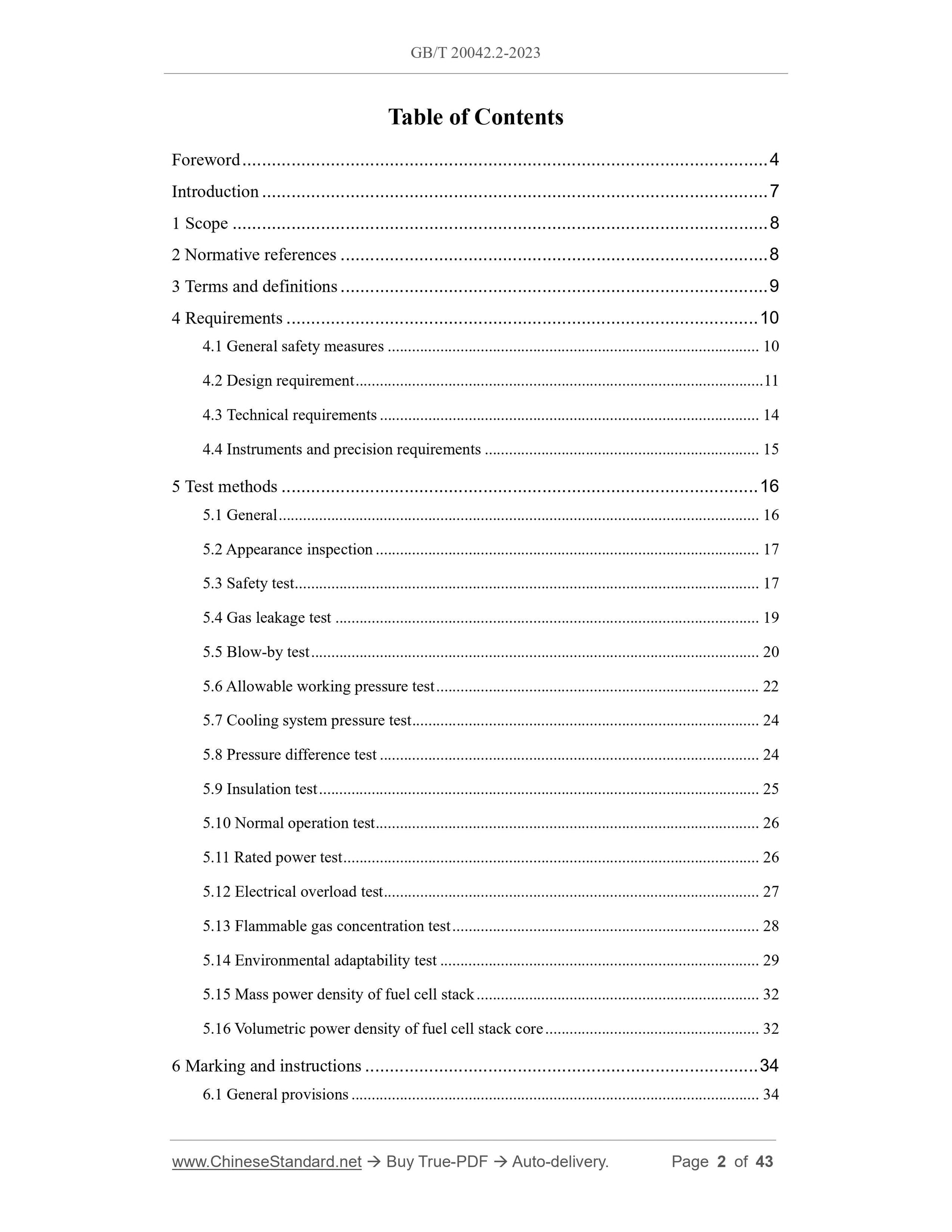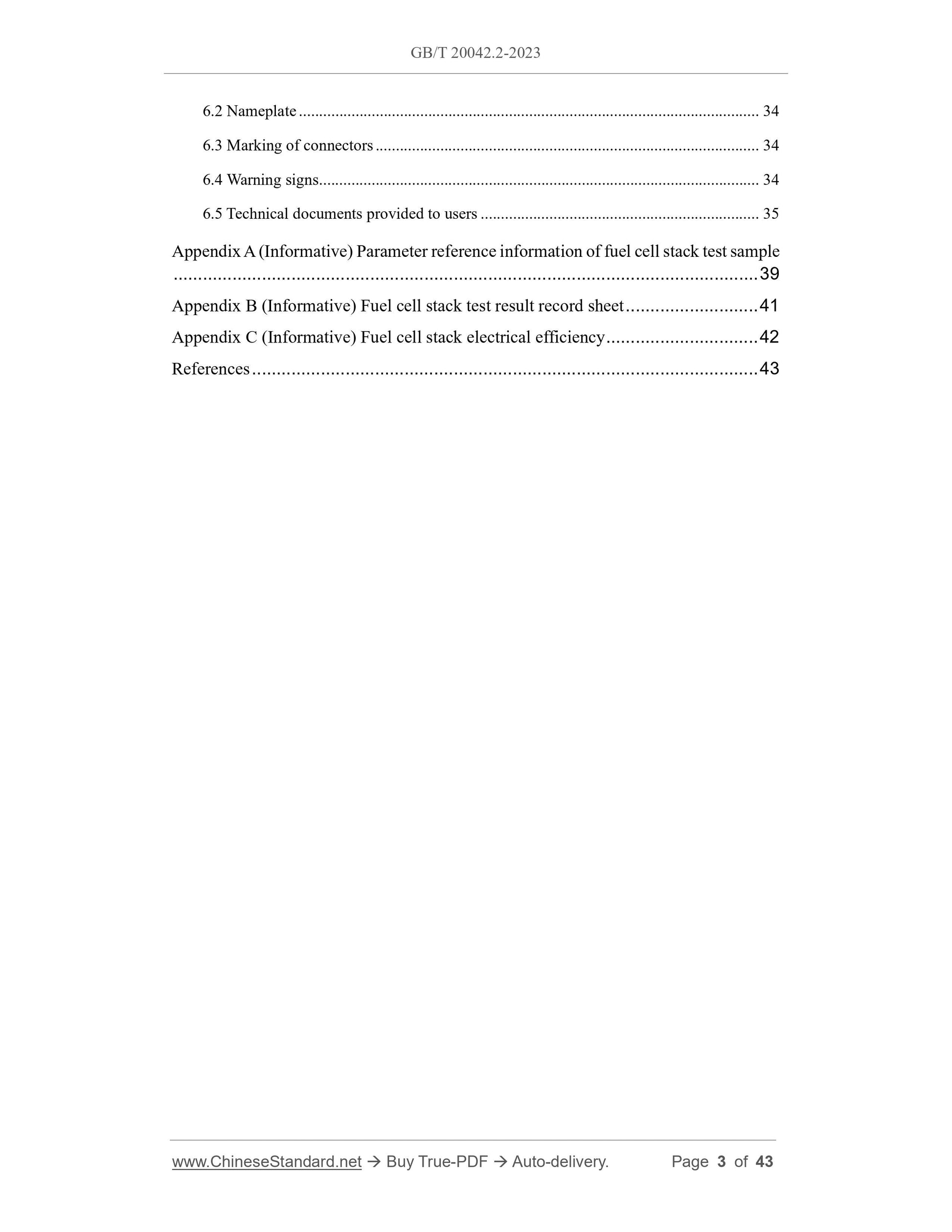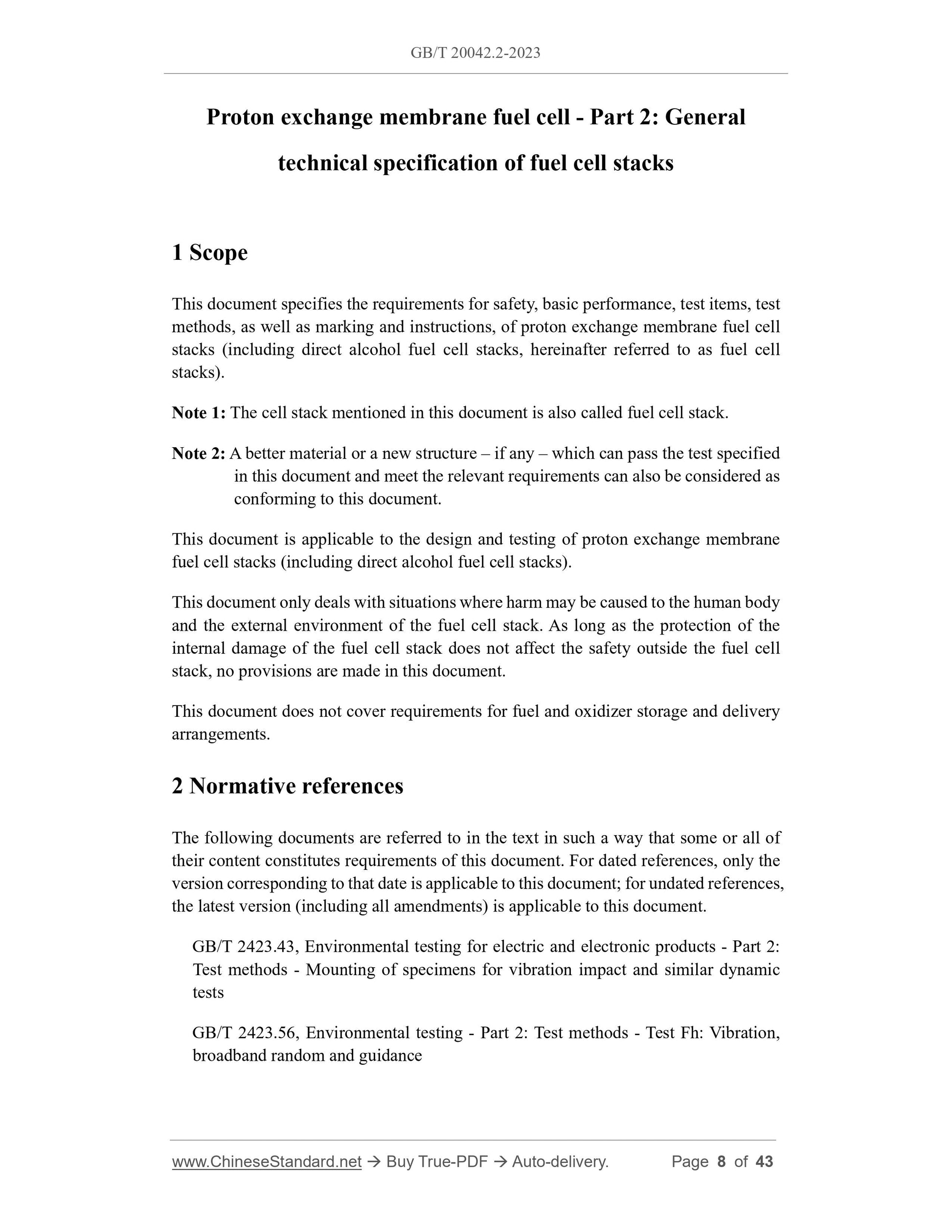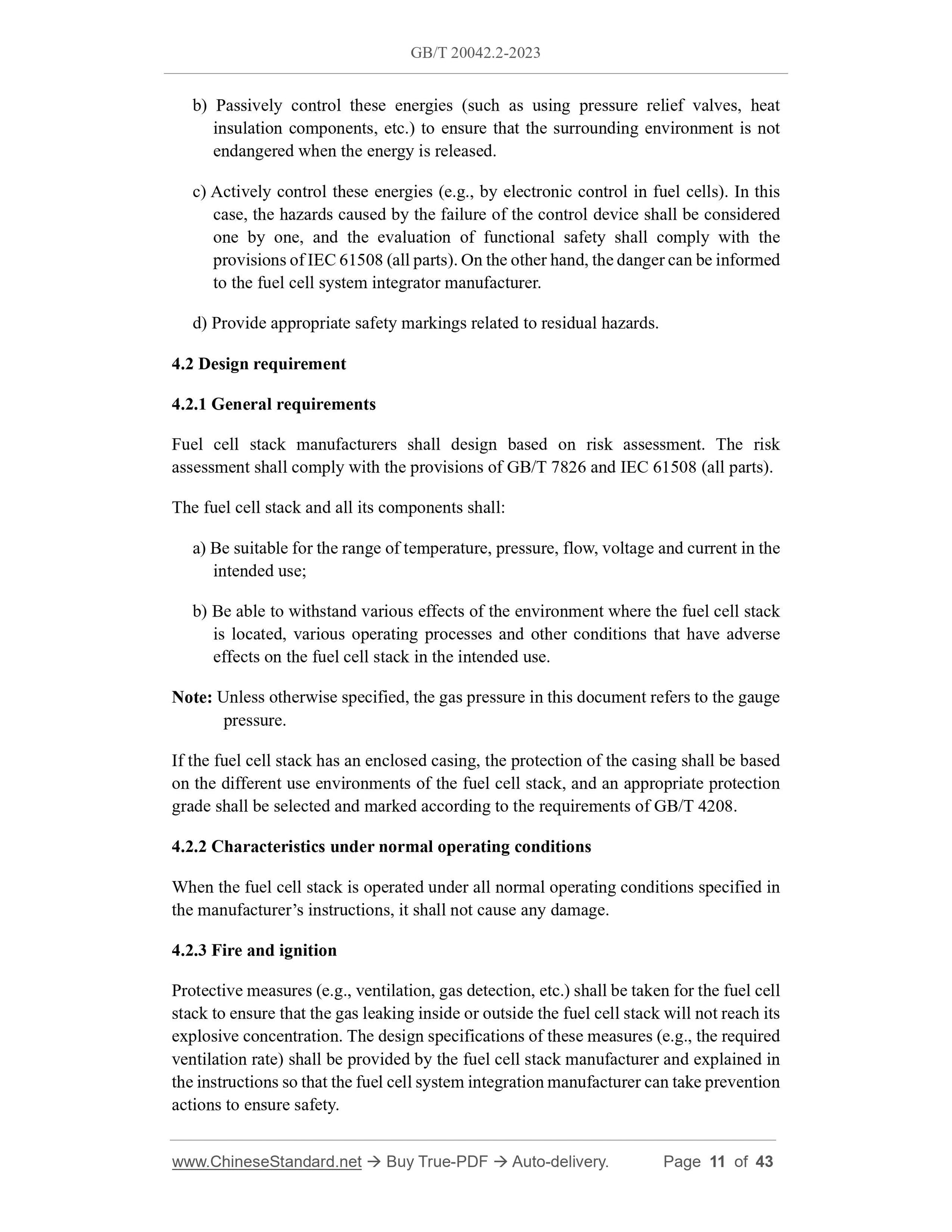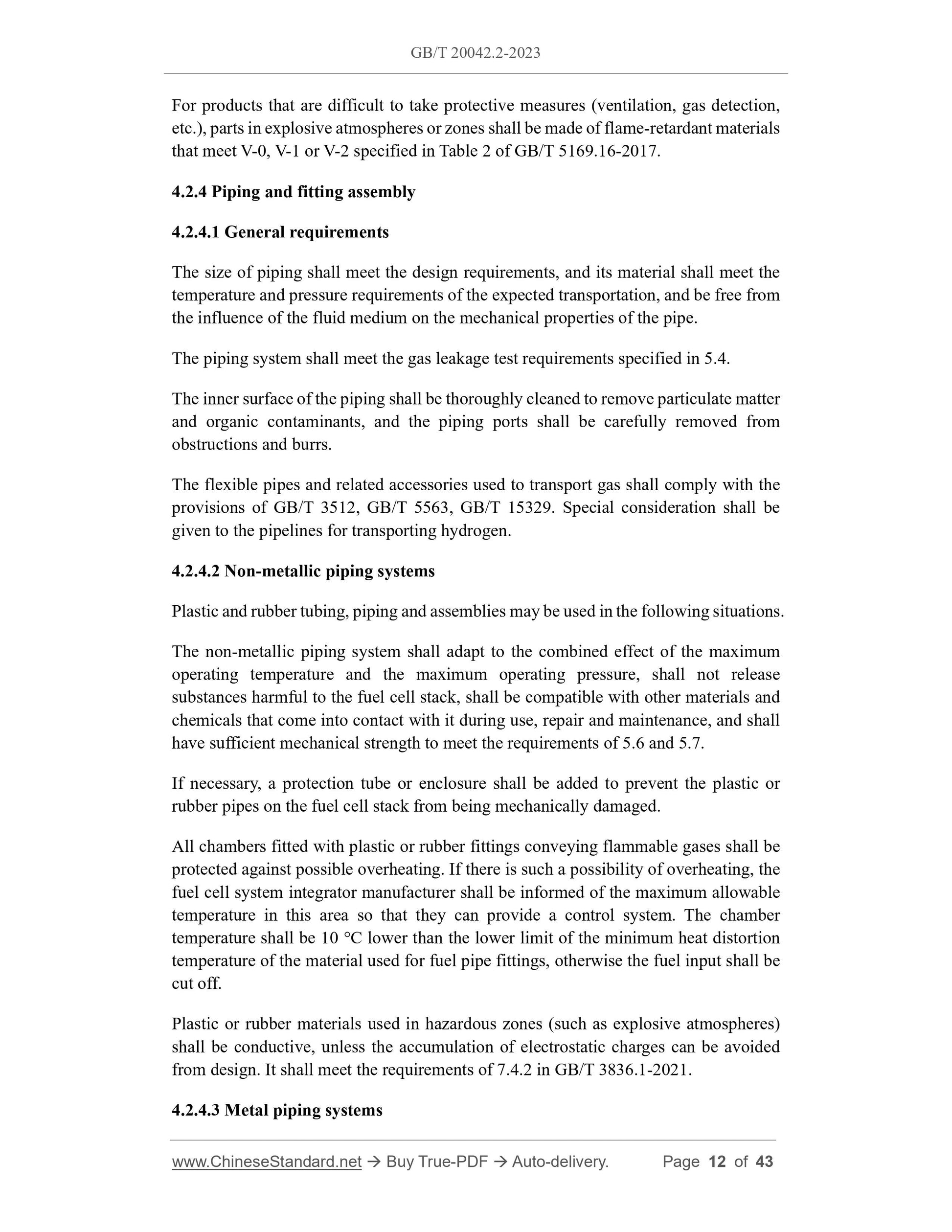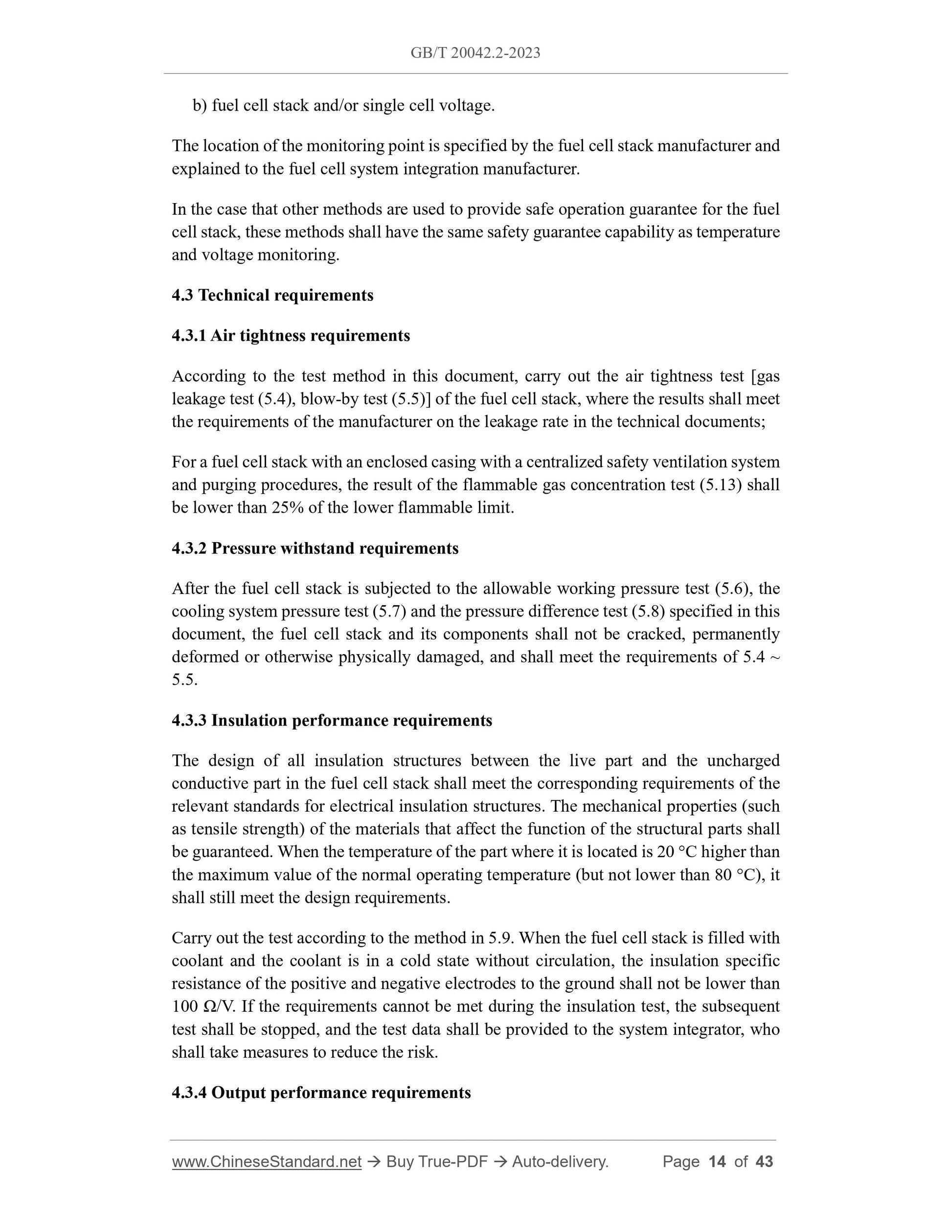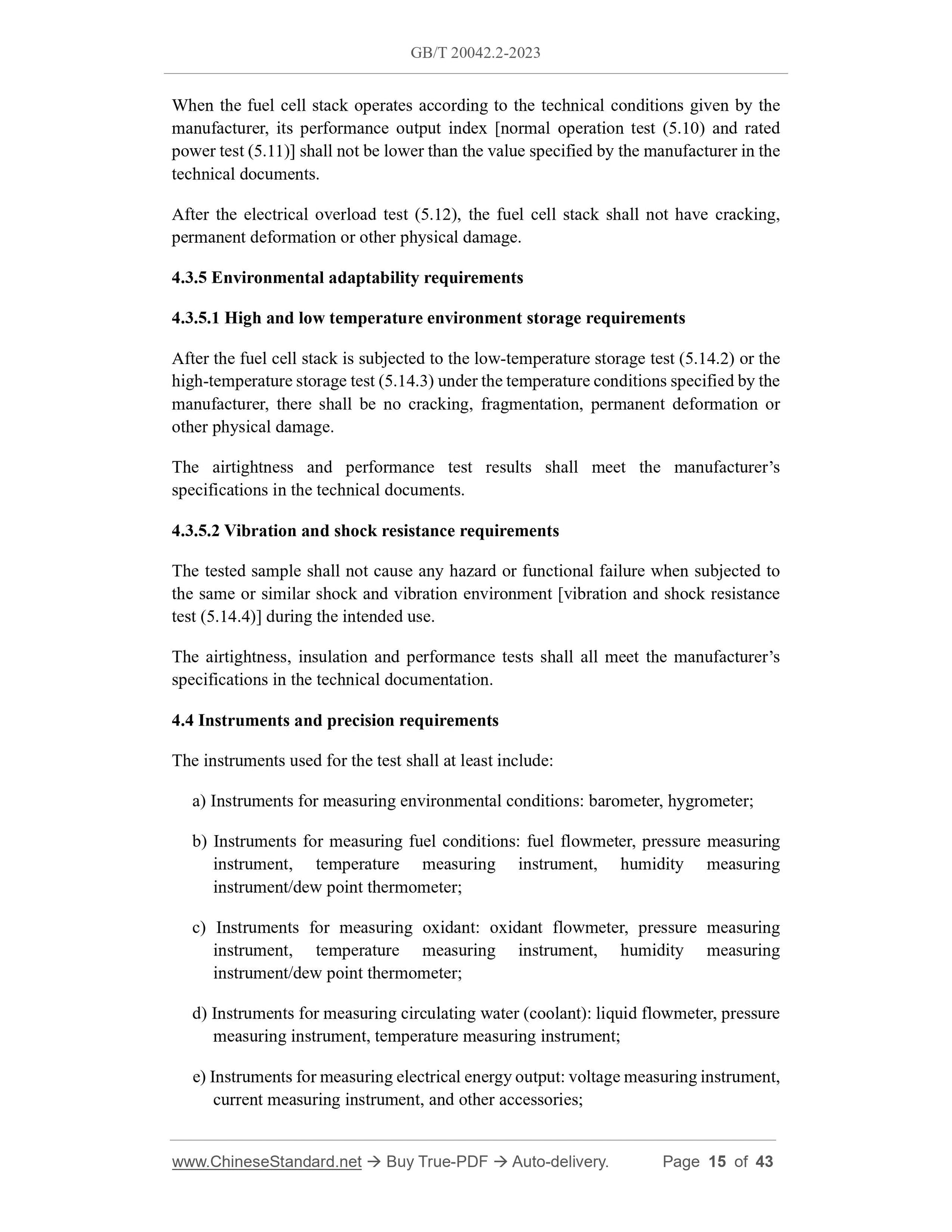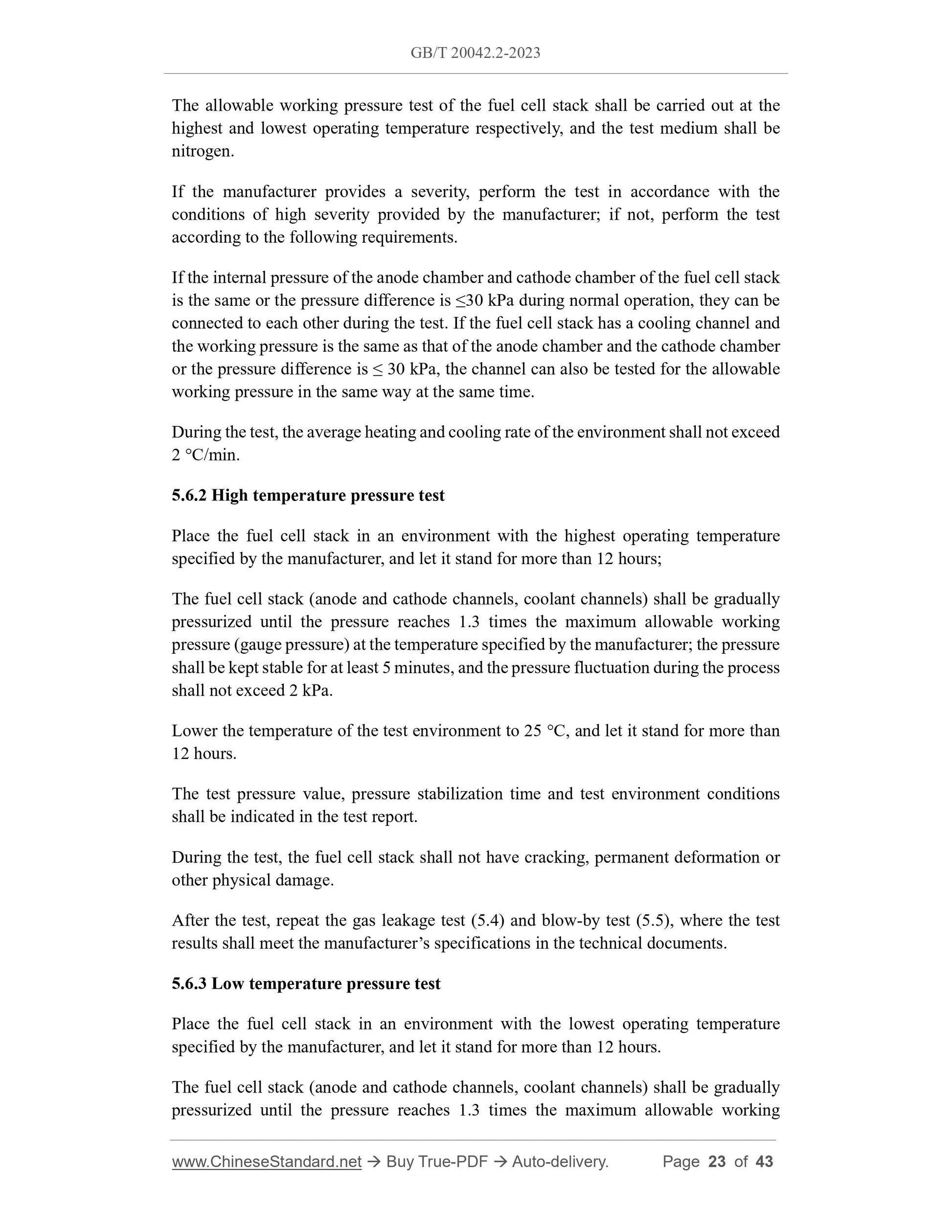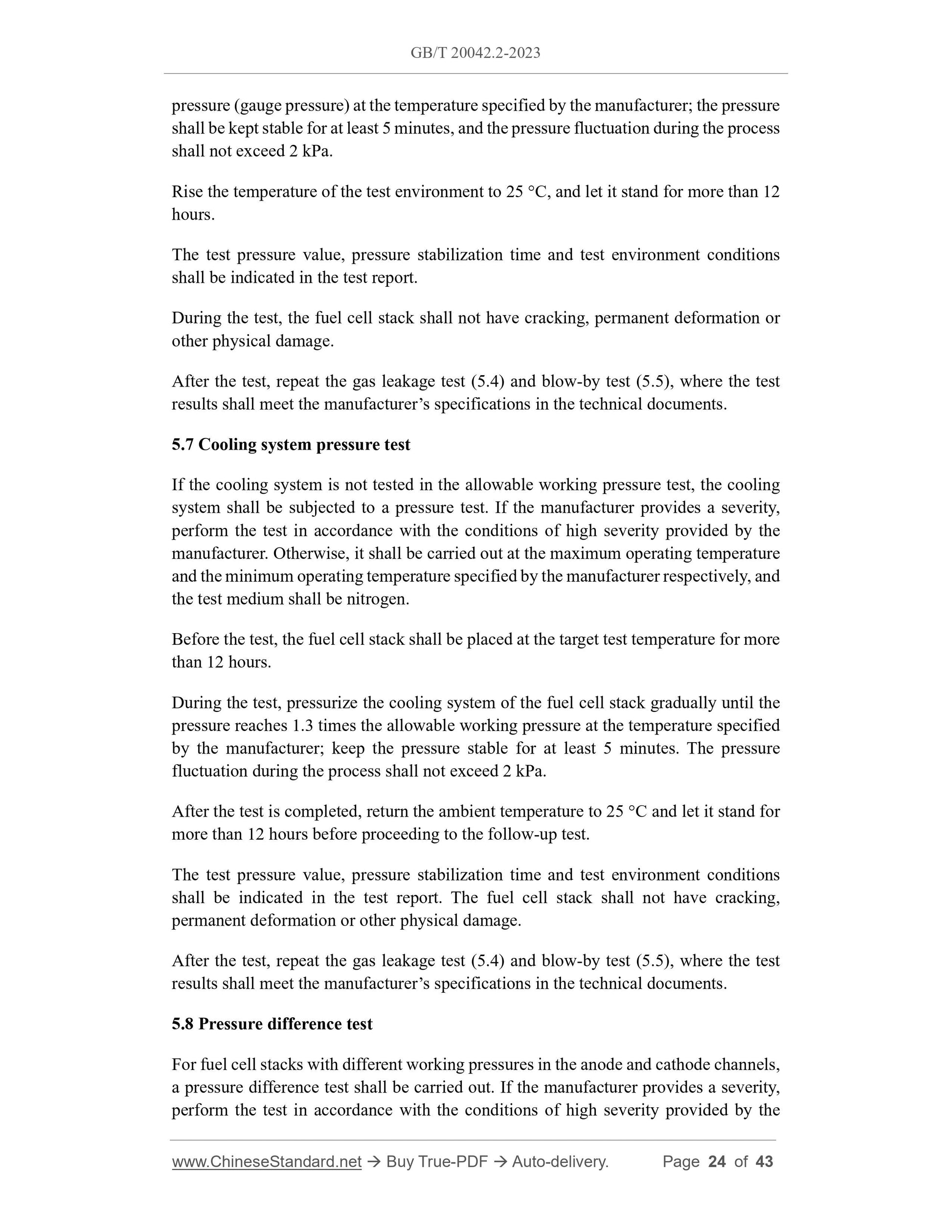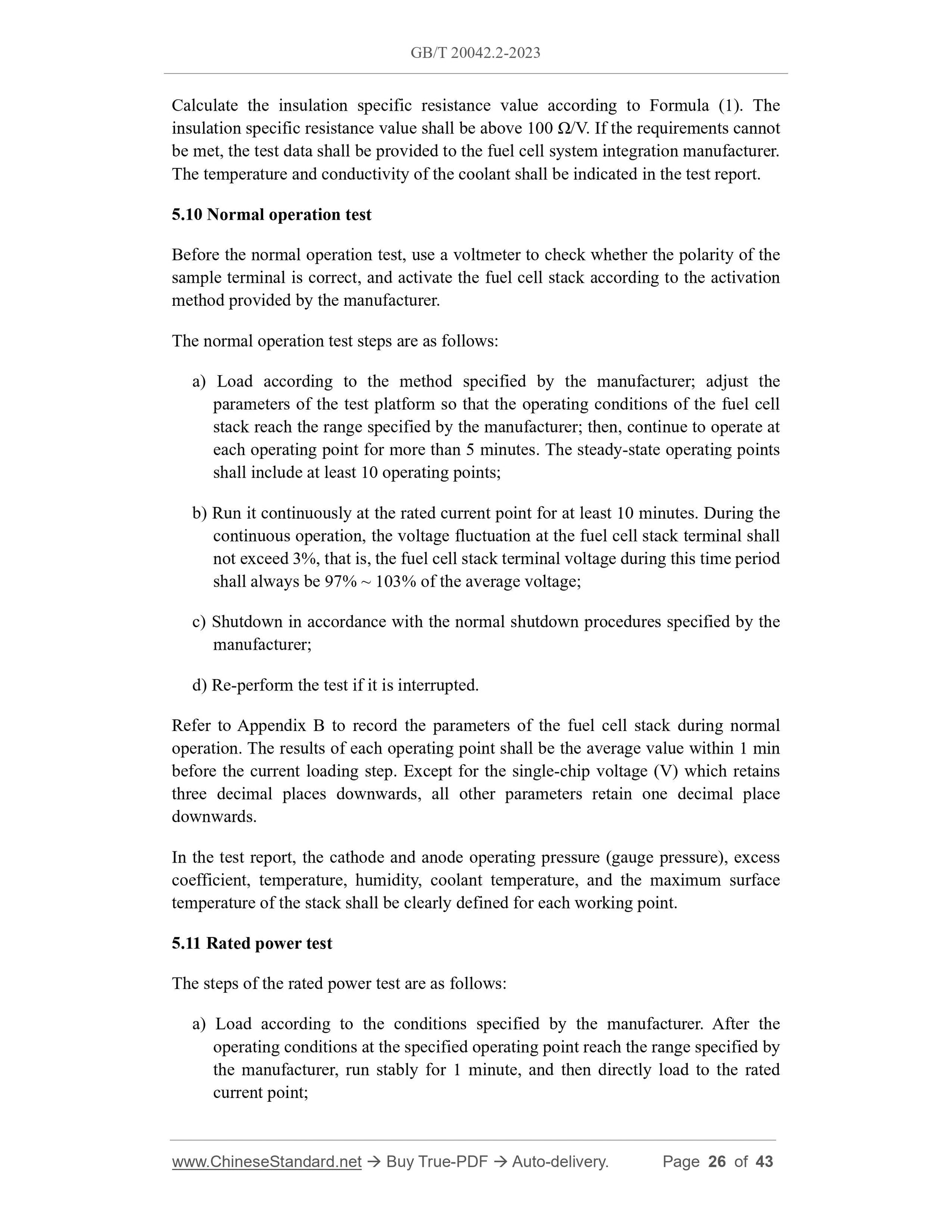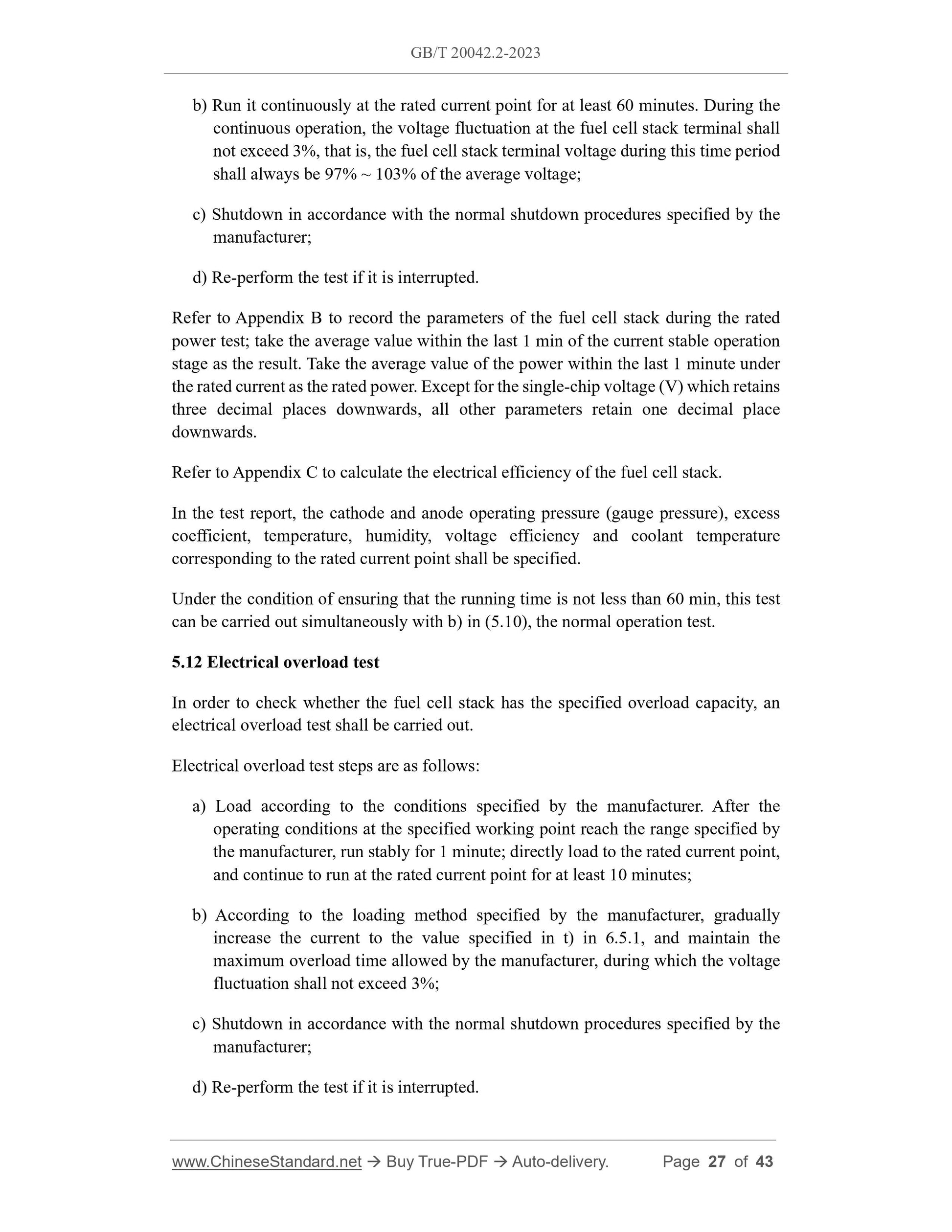1
/
of
12
PayPal, credit cards. Download editable-PDF & invoice In 1 second!
GB/T 20042.2-2023 English PDF (GBT20042.2-2023)
GB/T 20042.2-2023 English PDF (GBT20042.2-2023)
Regular price
$500.00 USD
Regular price
Sale price
$500.00 USD
Unit price
/
per
Shipping calculated at checkout.
Couldn't load pickup availability
Delivery: 3 seconds. Download true-PDF + Invoice.
Get QUOTATION in 1-minute: Click GB/T 20042.2-2023
Historical versions: GB/T 20042.2-2023
Preview True-PDF (Reload/Scroll if blank)
GB/T 20042.2-2023: Proton exchange membrane fuel cell -- Part 2: Ganeral technical spcecification of fuel cell stacks
GB/T 20042.2-2023
GB
NATIONAL STANDARD OF THE
PEOPLE’S REPUBLIC OF CHINA
ICS 27.070
CCS K 82
Replacing GB/T 20042.2-2008
Proton exchange membrane fuel cell - Part 2: General
technical specification of fuel cell stacks
ISSUED ON: MARCH 17, 2023
IMPLEMENTED ON: OCTOBER 01, 2023
Issued by: State Administration for Market Regulation;
Standardization Administration of the People’s Republic of China.
Table of Contents
Foreword ... 4
Introduction ... 7
1 Scope ... 8
2 Normative references ... 8
3 Terms and definitions ... 9
4 Requirements ... 10
4.1 General safety measures ... 10
4.2 Design requirement ... 11
4.3 Technical requirements ... 14
4.4 Instruments and precision requirements ... 15
5 Test methods ... 16
5.1 General ... 16
5.2 Appearance inspection ... 17
5.3 Safety test ... 17
5.4 Gas leakage test ... 19
5.5 Blow-by test ... 20
5.6 Allowable working pressure test ... 22
5.7 Cooling system pressure test ... 24
5.8 Pressure difference test ... 24
5.9 Insulation test ... 25
5.10 Normal operation test ... 26
5.11 Rated power test ... 26
5.12 Electrical overload test ... 27
5.13 Flammable gas concentration test ... 28
5.14 Environmental adaptability test ... 29
5.15 Mass power density of fuel cell stack ... 32
5.16 Volumetric power density of fuel cell stack core ... 32
6 Marking and instructions ... 34
6.1 General provisions ... 34
6.2 Nameplate ... 34
6.3 Marking of connectors ... 34
6.4 Warning signs ... 34
6.5 Technical documents provided to users ... 35
Appendix A (Informative) Parameter reference information of fuel cell stack test sample
... 39
Appendix B (Informative) Fuel cell stack test result record sheet ... 41
Appendix C (Informative) Fuel cell stack electrical efficiency ... 42
References ... 43
Proton exchange membrane fuel cell - Part 2: General
technical specification of fuel cell stacks
1 Scope
This document specifies the requirements for safety, basic performance, test items, test
methods, as well as marking and instructions, of proton exchange membrane fuel cell
stacks (including direct alcohol fuel cell stacks, hereinafter referred to as fuel cell
stacks).
Note 1: The cell stack mentioned in this document is also called fuel cell stack.
Note 2: A better material or a new structure – if any – which can pass the test specified
in this document and meet the relevant requirements can also be considered as
conforming to this document.
This document is applicable to the design and testing of proton exchange membrane
fuel cell stacks (including direct alcohol fuel cell stacks).
This document only deals with situations where harm may be caused to the human body
and the external environment of the fuel cell stack. As long as the protection of the
internal damage of the fuel cell stack does not affect the safety outside the fuel cell
stack, no provisions are made in this document.
This document does not cover requirements for fuel and oxidizer storage and delivery
arrangements.
2 Normative references
The following documents are referred to in the text in such a way that some or all of
their content constitutes requirements of this document. For dated references, only the
version corresponding to that date is applicable to this document; for undated references,
the latest version (including all amendments) is applicable to this document.
GB/T 2423.43, Environmental testing for electric and electronic products - Part 2:
Test methods - Mounting of specimens for vibration impact and similar dynamic
tests
GB/T 2423.56, Environmental testing - Part 2: Test methods - Test Fh: Vibration,
broadband random and guidance
b) Passively control these energies (such as using pressure relief valves, heat
insulation components, etc.) to ensure that the surrounding environment is not
endangered when the energy is released.
c) Actively control these energies (e.g., by electronic control in fuel cells). In this
case, the hazards caused by the failure of the control device shall be considered
one by one, and the evaluation of functional safety shall comply with the
provisions of IEC 61508 (all parts). On the other hand, the danger can be informed
to the fuel cell system integrator manufacturer.
d) Provide appropriate safety markings related to residual hazards.
4.2 Design requirement
4.2.1 General requirements
Fuel cell stack manufacturers shall design based on risk assessment. The risk
assessment shall comply with the provisions of GB/T 7826 and IEC 61508 (all parts).
The fuel cell stack and all its components shall:
a) Be suitable for the range of temperature, pressure, flow, voltage and current in the
intended use;
b) Be able to withstand various effects of the environment where the fuel cell stack
is located, various operating processes and other conditions that have adverse
effects on the fuel cell stack in the intended use.
Note: Unless otherwise specified, the gas pressure in this document refers to the gauge
pressure.
If the fuel cell stack has an enclosed casing, the protection of the casing shall be based
on the different use environments of the fuel cell stack, and an appropriate protection
grade shall be selected and marked according to the requirements of GB/T 4208.
4.2.2 Characteristics under normal operating conditions
When the fuel cell stack is operated under all normal operating conditions specified in
the manufacturer’s instructions, it shall not cause any damage.
4.2.3 Fire and ignition
Protective measures (e.g., ventilation, gas detection, etc.) shall be taken for the fuel cell
stack to ensure that the gas leaking inside or outside the fuel cell stack will not reach its
explosive concentration. The design specifications of these measures (e.g., the required
ventilation rate) shall be provided by the fuel cell stack manufacturer and explained in
the instructions so that the fuel cell system integration manufacturer can take prevention
actions to ensure safety.
For products that are difficult to take protective measures (ventilation, gas detection,
etc.), parts in explosive atmospheres or zones shall be made of flame-retardant materials
that meet V-0, V-1 or V-2 specified in Table 2 of GB/T 5169.16-2017.
4.2.4 Piping and fitting assembly
4.2.4.1 General requirements
The size of piping shall meet the design requirements, and its material shall meet the
temperature and pressure requirements of the expected transportation, and be free from
the influence of the fluid medium on the mechanical properties of the pipe.
The piping system shall meet the gas leakage test requirements specified in 5.4.
The inner surface of the piping shall be thoroughly cleaned to remove particulate matter
and organic contaminants, and the piping ports shall be carefully removed from
obstructions and burrs.
The flexible pipes and related accessories used to transport gas shall comply with the
provisions of GB/T 3512, GB/T 5563, GB/T 15329. Special consideration shall be
given to the pipelines for transporting hydrogen.
4.2.4.2 Non-metallic piping systems
Plastic and rubber tubing, piping and assemblies may be used in the following situations.
The non-metallic piping system shall adapt to the combined effect of the maximum
operating temperature and the maximum operating pressure, shall not release
substances harmful to the fuel cell stack, shall be compatible with other materials and
chemicals that come into c...
Get QUOTATION in 1-minute: Click GB/T 20042.2-2023
Historical versions: GB/T 20042.2-2023
Preview True-PDF (Reload/Scroll if blank)
GB/T 20042.2-2023: Proton exchange membrane fuel cell -- Part 2: Ganeral technical spcecification of fuel cell stacks
GB/T 20042.2-2023
GB
NATIONAL STANDARD OF THE
PEOPLE’S REPUBLIC OF CHINA
ICS 27.070
CCS K 82
Replacing GB/T 20042.2-2008
Proton exchange membrane fuel cell - Part 2: General
technical specification of fuel cell stacks
ISSUED ON: MARCH 17, 2023
IMPLEMENTED ON: OCTOBER 01, 2023
Issued by: State Administration for Market Regulation;
Standardization Administration of the People’s Republic of China.
Table of Contents
Foreword ... 4
Introduction ... 7
1 Scope ... 8
2 Normative references ... 8
3 Terms and definitions ... 9
4 Requirements ... 10
4.1 General safety measures ... 10
4.2 Design requirement ... 11
4.3 Technical requirements ... 14
4.4 Instruments and precision requirements ... 15
5 Test methods ... 16
5.1 General ... 16
5.2 Appearance inspection ... 17
5.3 Safety test ... 17
5.4 Gas leakage test ... 19
5.5 Blow-by test ... 20
5.6 Allowable working pressure test ... 22
5.7 Cooling system pressure test ... 24
5.8 Pressure difference test ... 24
5.9 Insulation test ... 25
5.10 Normal operation test ... 26
5.11 Rated power test ... 26
5.12 Electrical overload test ... 27
5.13 Flammable gas concentration test ... 28
5.14 Environmental adaptability test ... 29
5.15 Mass power density of fuel cell stack ... 32
5.16 Volumetric power density of fuel cell stack core ... 32
6 Marking and instructions ... 34
6.1 General provisions ... 34
6.2 Nameplate ... 34
6.3 Marking of connectors ... 34
6.4 Warning signs ... 34
6.5 Technical documents provided to users ... 35
Appendix A (Informative) Parameter reference information of fuel cell stack test sample
... 39
Appendix B (Informative) Fuel cell stack test result record sheet ... 41
Appendix C (Informative) Fuel cell stack electrical efficiency ... 42
References ... 43
Proton exchange membrane fuel cell - Part 2: General
technical specification of fuel cell stacks
1 Scope
This document specifies the requirements for safety, basic performance, test items, test
methods, as well as marking and instructions, of proton exchange membrane fuel cell
stacks (including direct alcohol fuel cell stacks, hereinafter referred to as fuel cell
stacks).
Note 1: The cell stack mentioned in this document is also called fuel cell stack.
Note 2: A better material or a new structure – if any – which can pass the test specified
in this document and meet the relevant requirements can also be considered as
conforming to this document.
This document is applicable to the design and testing of proton exchange membrane
fuel cell stacks (including direct alcohol fuel cell stacks).
This document only deals with situations where harm may be caused to the human body
and the external environment of the fuel cell stack. As long as the protection of the
internal damage of the fuel cell stack does not affect the safety outside the fuel cell
stack, no provisions are made in this document.
This document does not cover requirements for fuel and oxidizer storage and delivery
arrangements.
2 Normative references
The following documents are referred to in the text in such a way that some or all of
their content constitutes requirements of this document. For dated references, only the
version corresponding to that date is applicable to this document; for undated references,
the latest version (including all amendments) is applicable to this document.
GB/T 2423.43, Environmental testing for electric and electronic products - Part 2:
Test methods - Mounting of specimens for vibration impact and similar dynamic
tests
GB/T 2423.56, Environmental testing - Part 2: Test methods - Test Fh: Vibration,
broadband random and guidance
b) Passively control these energies (such as using pressure relief valves, heat
insulation components, etc.) to ensure that the surrounding environment is not
endangered when the energy is released.
c) Actively control these energies (e.g., by electronic control in fuel cells). In this
case, the hazards caused by the failure of the control device shall be considered
one by one, and the evaluation of functional safety shall comply with the
provisions of IEC 61508 (all parts). On the other hand, the danger can be informed
to the fuel cell system integrator manufacturer.
d) Provide appropriate safety markings related to residual hazards.
4.2 Design requirement
4.2.1 General requirements
Fuel cell stack manufacturers shall design based on risk assessment. The risk
assessment shall comply with the provisions of GB/T 7826 and IEC 61508 (all parts).
The fuel cell stack and all its components shall:
a) Be suitable for the range of temperature, pressure, flow, voltage and current in the
intended use;
b) Be able to withstand various effects of the environment where the fuel cell stack
is located, various operating processes and other conditions that have adverse
effects on the fuel cell stack in the intended use.
Note: Unless otherwise specified, the gas pressure in this document refers to the gauge
pressure.
If the fuel cell stack has an enclosed casing, the protection of the casing shall be based
on the different use environments of the fuel cell stack, and an appropriate protection
grade shall be selected and marked according to the requirements of GB/T 4208.
4.2.2 Characteristics under normal operating conditions
When the fuel cell stack is operated under all normal operating conditions specified in
the manufacturer’s instructions, it shall not cause any damage.
4.2.3 Fire and ignition
Protective measures (e.g., ventilation, gas detection, etc.) shall be taken for the fuel cell
stack to ensure that the gas leaking inside or outside the fuel cell stack will not reach its
explosive concentration. The design specifications of these measures (e.g., the required
ventilation rate) shall be provided by the fuel cell stack manufacturer and explained in
the instructions so that the fuel cell system integration manufacturer can take prevention
actions to ensure safety.
For products that are difficult to take protective measures (ventilation, gas detection,
etc.), parts in explosive atmospheres or zones shall be made of flame-retardant materials
that meet V-0, V-1 or V-2 specified in Table 2 of GB/T 5169.16-2017.
4.2.4 Piping and fitting assembly
4.2.4.1 General requirements
The size of piping shall meet the design requirements, and its material shall meet the
temperature and pressure requirements of the expected transportation, and be free from
the influence of the fluid medium on the mechanical properties of the pipe.
The piping system shall meet the gas leakage test requirements specified in 5.4.
The inner surface of the piping shall be thoroughly cleaned to remove particulate matter
and organic contaminants, and the piping ports shall be carefully removed from
obstructions and burrs.
The flexible pipes and related accessories used to transport gas shall comply with the
provisions of GB/T 3512, GB/T 5563, GB/T 15329. Special consideration shall be
given to the pipelines for transporting hydrogen.
4.2.4.2 Non-metallic piping systems
Plastic and rubber tubing, piping and assemblies may be used in the following situations.
The non-metallic piping system shall adapt to the combined effect of the maximum
operating temperature and the maximum operating pressure, shall not release
substances harmful to the fuel cell stack, shall be compatible with other materials and
chemicals that come into c...
Share
